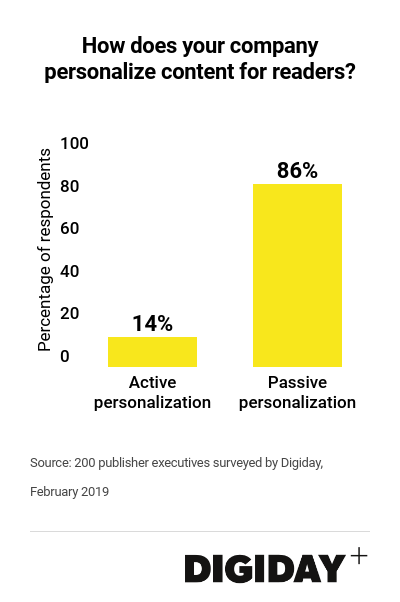Digiday Research: 70 percent of publishers say they personalize content
This research is based on unique data collected from our proprietary audience of publisher, agency, brand and tech insiders. It’s available to Digiday+ members. More from the series →
A survey of 200 publishers by Digiday this month found that most (70 percent) personalize the content they deliver to visitors. Once frowned upon by editors and consumers alike, the practice is becoming mainstream or publishers are now more willing to talk about it.
However, readers might not always be aware they are served different content than the person sitting next to them. Eight-four percent of publishers that do personalize content said they conduct passive personalization rather than active personalization. Passive personalization utilizes information like readers’ location or browsing history to tailor to the content they see, whereas readers self-select the content they wish to see more or less of in active personalization.
Over time, personalization is likely to become more popular among publishers. Half of publishers that do not currently personalize content said they are developing plans to do so
Costs, both technical and monetary, are holding publishers back from achieving personalization. Sixty-eight percent of companies that do not personalize content said they lack the technical expertise required and 58 percent were short of funding for such projects.
Fewer respondents choose not to tailor content for readers due to ethical qualms or potential sources of backlash according to the Digiday survey. Only a quarter of respondents not personalizing content said it ran counter to their editorial missions and just 14 percent were worried about potential pushback from editors.
.

“Overall, I’ve seen publishers worry about not sounding caught-up if they’re not doing some form of personalization,” said one anonymous publisher executive. “They think they’re being left behind.”
Part of why personalization has become so widespread among publishers is that it has become a catchall for a number of projects. Tailored content has evolved beyond algorithms customizing homepages and now includes everything from popular-articles widgets to newsletters constructed based on reader interests.

“We don’t hear about personalization from readers,” said Jason Jedlinski, svp of consumer products at Gannett. He pointed out to social platforms like Facebook and Twitter for changing readers expectations around personalization.

More in Media

Digiday+ Research: Publishers’ growing focus on video doesn’t translate to social platforms
Major publishers have made recent investments in vertical video, but that shift is not carrying over to social media platforms.

Technology x humanity: A conversation with Dayforce’s Amy Capellanti-Wolf
Capellanti-Wolf shared insight on everything from navigating AI adoption and combating burnout to rethinking talent strategies.

How The Arena Group is rewriting its commercial playbook for the zero-click era
The company is testing AI-powered content recommendation models to keep readers moving through its network of sites and, in doing so, bump up revenue per session – its core performance metric.





